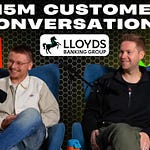Video Transcript:
(00:00:23):
Most businesses in recent years have differentiated based on customer experience,
(00:00:28):
but generative AI is potentially going to change all of that entirely.
(00:00:33):
If you think about most businesses,
(00:00:35):
most businesses in most sectors are pretty much exactly the same.
(00:00:39):
If you're a bank, all banks do the same stuff.
(00:00:41):
Most car manufacturers are all the same.
(00:00:44):
A lot of the cars are built on the same chassis.
(00:00:46):
They use the same engines.
(00:00:47):
You can't differentiate on the product itself.
(00:00:49):
You can't differentiate on the brand itself anymore unless you've got a
(00:00:52):
particularly strong brand like Apple or Nike or something similar.
(00:00:54):
So it's experience and the experience layer has really been where businesses have
(00:00:58):
been able to create some kind of differentiation.
(00:01:01):
I can't tell you how many banks that I've moved from because of the poor online experience.
(00:01:06):
But with the generative AI technologies that exist today,
(00:01:10):
The value of providing great experiences is still just as valuable as it was before.
(00:01:15):
There are so many terrible IVR systems.
(00:01:18):
There are so many terrible chatbots.
(00:01:21):
But if everybody is using the same models,
(00:01:25):
then does that mean that over time the experience of having these conversations
(00:01:29):
becomes homogenized and becomes so similar that if you're talking to direct line,
(00:01:35):
you may as well be talking to Hastings because they're all using the same
(00:01:38):
fundamental models that are all doing the same kind of stuff.
(00:01:41):
The only difference is really that your answer is going to be slightly different
(00:01:44):
based on the policy.
(00:01:45):
There is a risk here that everybody using all of the same technology creates this homogenous,
(00:01:51):
albeit working,
(00:01:53):
experience that then makes it very difficult to differentiate.
(00:01:58):
So the question is, how do you differentiate
(00:02:01):
in a generative AI era.
(00:02:03):
And one of the ways I think businesses can differentiate is through considering
(00:02:08):
creating their own fine-tuned models for specific capabilities.
(00:02:13):
Large language models are going to become more capable,
(00:02:16):
although potentially there's a plateau that we're going to see there.
(00:02:19):
But needless to say, large language models can do a lot of the tasks that you need them to do.
(00:02:23):
They can vectorize content so that you can use retrieval augmented generation.
(00:02:28):
They can create summaries of multiple documents to answer complex user questions.
(00:02:32):
They can classify intents,
(00:02:35):
for want of a better phrase,
(00:02:36):
to understand what people mean when they say whatever it is.
(00:02:39):
that they say.
(00:02:40):
They can do things like entity extraction to take out important information from a
(00:02:45):
customer utterance.
(00:02:46):
They can do things that NLU systems couldn't do very well, which is process long user inputs.
(00:02:51):
If someone writes you an essay or sends you an email,
(00:02:54):
traditional NLU systems have often struggled to understand what to do with those things.
(00:02:58):
So large language models are incredibly capable and can do a lot of this stuff very well.
(00:03:02):
The problem is, is that they don't do it very fast.
(00:03:06):
So if you wanted to have an experience that runs on the voice channel,
(00:03:08):
for example,
(00:03:09):
either a voice interface that runs in an app or something that you can call and
(00:03:12):
speak to,
(00:03:13):
the inference time of large language models tends to be a little bit too long.
(00:03:17):
And also the cost of the inference on a large language model is typically going to
(00:03:21):
be a lot higher than it would be if you were to use another model of some other description.
(00:03:26):
With a small language model,
(00:03:27):
for example,
(00:03:28):
a fine-tuned small language model,
(00:03:29):
you might find that you can get faster performance.
(00:03:31):
You might find that you can secure it a bit better and run it on your own servers
(00:03:35):
rather than using APIs and pinging it off to some unknown cloud somewhere.
(00:03:39):
You can fine-tune them a lot more easily,
(00:03:41):
which means that you can customize them for very specific use cases.
(00:03:45):
And if you think about customers and users that are going to talk to your business...
(00:03:51):
The fundamental first thing you've got to get right is you have to be able to understand them.
(00:03:56):
I think that where businesses are going to end up,
(00:03:58):
and this is the direction that you should be trying to move in,
(00:04:00):
is you need to have a channel strategy in place,
(00:04:03):
which means that regardless of where customers contact you on,
(00:04:07):
regardless of what channel that is,
(00:04:08):
whether it's through social media,
(00:04:09):
whether it's sending you an email,
(00:04:10):
calling your contact center,
(00:04:12):
or using the live chat on your website,
(00:04:13):
or using your chatbot,
(00:04:15):
or in your mobile app,
(00:04:16):
wherever they go,
(00:04:18):
The first thing that they're going to hit is going to be your AI assistant or AI agent,
(00:04:23):
if you want to give it that term.
(00:04:25):
That AI assistant's first primary job is going to be understanding what it is
(00:04:29):
you're trying to get done and matching that to something that the business can help
(00:04:33):
you with.
(00:04:34):
Often, that's not going to be something that it can help you with directly.
(00:04:39):
If you send a bank a message on Instagram and you're asking it to transfer some
(00:04:43):
money or what have you,
(00:04:44):
it's not going to do that on Instagram messaging because it can't authenticate you
(00:04:48):
and that's just not going to happen.
(00:04:50):
So it might then suggest that actually for this, you may as well use the app.
(00:04:53):
Or if you call your bank and the bank knows that you're registered for mobile
(00:04:56):
banking and it can see that you're logged in on your mobile bank,
(00:04:59):
it might just send you a push notification once it understands your intent.
(00:05:02):
so that you can just get that thing done in the banking app rather than taking time
(00:05:06):
away from people who would otherwise answer the phone and take time away from other
(00:05:10):
people who would need that service more.
(00:05:13):
So one of the ways in which a business can differentiate using AI is to do
(00:05:19):
something like that,
(00:05:20):
which is to customize certain models to be able to provide certain capabilities
(00:05:26):
better than you would find in an off-the-shelf vendor and better than your
(00:05:30):
competitors can do so.
(00:05:32):
Classification is just one example.
(00:05:34):
Triaging is another example.
(00:05:36):
Entity extraction is a marginal gain because ultimately there's going to be lots of
(00:05:40):
models that are going to be able to do that kind of thing.
(00:05:42):
But you can see what I'm getting at.
(00:05:44):
Where is it in your business that you believe you have either intellectual property
(00:05:49):
or the ability to create significant value through having your own fine-tuned model?
(00:05:55):
For me, that's the area of differentiation.
(00:05:58):
It's still at the experience layer,
(00:06:00):
But it's in being smarter and more intelligent than what you're likely to find from
(00:06:06):
all of the rest of the competitors that you've got.
(00:06:08):
Most of your competitors today are going to be using retrieval augmented generation.
(00:06:12):
That's going to be where their use of generative AI starts and stops.
(00:06:16):
And the problem with retrieval augmented generation in a business context is that
(00:06:20):
although it can answer questions,
(00:06:21):
it doesn't have an awareness of the conversation.
(00:06:24):
It doesn't understand whether this question that's come from a customer is a
(00:06:27):
sales-based question,
(00:06:29):
whether it's a support-based question.
(00:06:31):
It doesn't understand what products and services sit underneath that request, really.
(00:06:34):
It's just looking for patterns in a semantic similarity based on content that you've got.
(00:06:39):
So it can't understand where the customer is in their journey.
(00:06:42):
It can't marry together the products and services that you have against that stage
(00:06:46):
of the journey.
(00:06:47):
And therefore, it can't actually be useful.
(00:06:49):
So in a telco example,
(00:06:51):
if I say something like,
(00:06:54):
how do I go about upgrading my account or upgrading my contract?
(00:06:59):
The retrieval augmented generation response to that is going to be,
(00:07:02):
oh,
(00:07:02):
simple,
(00:07:02):
to upgrade your contract,
(00:07:03):
all you need to do is go and pay off your other contract and then find a phone and
(00:07:06):
take out a new contract,
(00:07:07):
full stop.
(00:07:08):
And this is what I call a full stop problem,
(00:07:09):
which is that it doesn't understand that what I'm telling you there is that I'm
(00:07:13):
talking about renewing my contract.
(00:07:15):
That's a revenue-based conversation.
(00:07:17):
What you should be doing instead of ending that response with a full stop is you
(00:07:20):
should be saying,
(00:07:21):
have you found a phone that you like?
(00:07:22):
Do you want to log in and let me look up your account information?
(00:07:24):
Let's see how long you got left on your contract.
(00:07:26):
Let's move the conversation forward.
(00:07:29):
And so these are the areas I think that businesses can differentiate on.
(00:07:32):
One,
(00:07:32):
you can understand customers better potentially by having your own fine-tuned
(00:07:37):
models that understand far more effectively.
(00:07:40):
Second,
(00:07:41):
triaging users and customers to the most appropriate channel where they can get
(00:07:44):
their issues resolved.
(00:07:46):
Third,
(00:07:47):
in conversation,
(00:07:48):
being a lot more sensible and intelligent about having awareness of the customer
(00:07:51):
journey and the real needs they're trying to get solved.
(00:07:54):
And then fourth,
(00:07:55):
crafting really compelling,
(00:07:57):
really natural,
(00:07:58):
engaging,
(00:07:59):
fluid,
(00:08:00):
easy to use,
(00:08:01):
effortless experiences that help customers get stuff done there and then in channel.
(00:08:06):
So it's an interesting time.
(00:08:08):
And it's a time where most businesses are scrambling just to get some generative AI
(00:08:13):
use cases off the ground.
(00:08:15):
That's where you're going to find the homogeny.
(00:08:18):
What you really need to be doing is focusing more on the experience.










